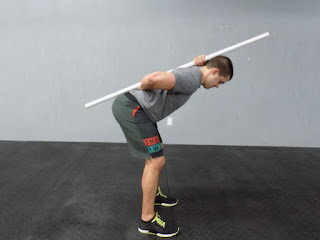Today's Guest Post is from Dr. Zach Long, of thebarbellphysio.com! You can actually take what he is posting here and apply it to any athlete or anyone into fitness/yoga/pilates, etc. Thanks Zach!
As a physical therapist and a CrossFit coach, I regularly
have the opportunity to analyze the movement and mobility of CrossFit athletes.
In my experience, the majority of these athletes will have at least one of the
following limitations resulting in injury risk or decreased performance.
1. Dorsiflexion
Without a doubt, this is the most common mobility
restriction I see. When ankle mobility is poor, it results in a huge variety of
movement faults and injuries. To test, I have the athlete begin in half
kneeling with their big toe one hand-width away from a wall. The athlete then
moves their knee towards the wall while keeping their foot flat on the floor
and pointed forward. Inability to touch the kneecap to the wall indicates
restricted dorsiflexion.
2. Hip Internal Rotation
While pushing the knees out while squatting puts the hip in
a position that allows for more squat depth, I often see athletes who push
their knees out to extremes while squatting. These athletes are often unable to
squat to depth without pushing their knees really far out, or they complain of
pinching in the anterior hip when squatting.
To assess, have the athlete lie on your back with his or her
thigh vertical and knee flexed to 90 degrees. While maintaining the vertical
thigh, move the foot outward to internally rotate the hip. Thirty degrees of
hip internal rotation should be available.
3. Shoulder Internal Rotation
When shoulder internal rotation is limited, CrossFit
athletes tend to get their shoulders in some pretty poor positions during a
variety of exercises such as cleans and snatches. This results in unnecessary
tissue stress and puts the shoulder in a poor position for generating force.
To test, the athlete lies on his or her back with their arm
abducted to 90 degrees. With a partner stabilizing the anterior shoulder to
prevent the shoulder blade from compensating, the shoulder is passively
internally rotated. I like to see approximately 70 degrees of internal
rotation.
4. Thoracic spine
rotation and extension
Thoracic spine mobility plays a huge role in overhead
mobility and decreasing mobility needs from the lumbar spine. The athlete
begins by sitting on their heels with their knees on the ground. They then
place one forearm flat on the ground and take the opposite hand and place in on
their low back. While keeping their butt on their heels and not shifting their
weight to the side, the athlete rotates as far as possible away from the down
arm. Fifty degrees of rotation (shoulders in relation to the ground) should be
available each direction.
5. Hip hinge
Testing a CrossFit athlete’s ability to perform a strict hip
hinge gives me a lot of insight into their ability to load their hip muscles
while maintaining a neutral spine. It amazes me how many athletes cannot
disassociate hip flexion from lumbar flexion. This results in low back pain and
decreased hip power.
To test, I have the athlete place a dowel along their spine
so that it is contacting their sacrum, thoracic spine, and posterior head. One
hand holds the dowel in the lumbar spine and the other behind the cervical
spine. The athlete begins with a slight knee bend and is instructed to not bend
the knees further (to avoid this becoming a squat). The athlete is instructed
to bend a their hips as far as the can while maintaining the three previously
mentioned points of contact between the dowel and their spine. CrossFit
athletes should be able to hinge far enough down that if they dropped the dowel
in the bottom position, their hands should reach their knees.
About the Author
Zach Long is a physical therapist and CrossFit coach in
Charlotte, NC. To learn more about Zach’s work and treatment philosophies,
visit www.thebarbellphysio.com.
Keeping it Eclectic...















Post a Comment
Post a Comment